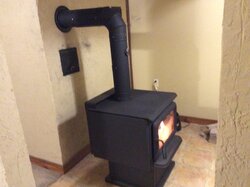I know its not spec, but I think it should be okay -- even though the wall is drywall, I think the distance is enough to not worry about the paper/cardboard sheathing combusting - and as far as I know the gypsum itself is non-combustible, and there there is absolutely no wood studding or framing behind -- that's all metal ... and the floor is granite porcelain tile, plus the base under the stove is 15 cm thick dolomite copping stones from demolition of a very old building in Jersualem - so nothing combustible there ... where the flue hits the wood ceiling and through to above the roof is a double walled fully insulated sleeve that was custom fabricated for the job, and the transition to class A flue takes place a good 25 cm before it even approaches that sleeve, so everything up above looks good -- so no shortcuts there ... I spoke to both the installer and the stove dealer this morning and both felt 100% about the situation -- and overall they have seemed trustworthy to me ...
Pacific Energy stove question -- Israel...
- Thread starter Avi
- Start date
-
Active since 1995, Hearth.com is THE place on the internet for free information and advice about wood stoves, pellet stoves and other energy saving equipment.
We strive to provide opinions, articles, discussions and history related to Hearth Products and in a more general sense, energy issues.
We promote the EFFICIENT, RESPONSIBLE, CLEAN and SAFE use of all fuels, whether renewable or fossil. -
Super Cedar firestarters 30% discount Use code Hearth2024 Click here


